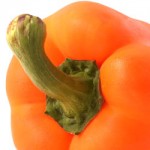When to harvest tomato fruit
The ripening stage when tomato fruit are harvested will depend on the variety, the market segment (do they want red full ripe tomatoes or does the consumer want the tomato to ripen at home) and market distance. In most cases, tomatoes are harvested just after some red discolouration has set in. The grower knows (and most consumers) that the ripening process has started and will continue until it goes fully red. Any grower will always perform a couple of tests during the growth season to see the condition of the gel inside the fruit when green. Note that there are some varieties that tend to go red inside first, so always test and compare the various ripening stages.
There are 6 accepted colour designations:
- Stage 1: Green – surface of the tomato is completely green
- Stage 2: Breakers – a definite break in colour from green to tan-yellow, pink or red on no more than 10% of the surface
- Stage 3: Turning – more than 10% but less than 30% of the surface, in the aggregate, shows change as in stage 2
- Stage 4: Pink – more than 30% but less than 60% of aggregate surface shows pink or red colour. The yellow tan colour is not longer visible
- Stage 5: Light Red – more than 60% of aggregate surface is reddish pink or red provided that not more than 90 % is red
- Stage 6: Red – more than 90% of surface in the aggregate show red colour and no pink is visible
The temperature at which tomatoes are stored will depend on their maturity and if pre-cooling is required. Since the temperature requirements for mature green and ripe fruits differ, they will be discussed separately.
Mature green tomatoes
If the tomato fruits are harvested at the mature green stage (stage 1), and the ripening process needs to be delayed due to transport, and the temperature of the fruit is below 27°C, pre-cooling is required. Tomatoes will not ripen normally at temperatures above 27°C. The ideal temperature for slow ripening mature green tomatoes is between 14 and 16°C. At these temperatures decay problems are at their minimum.
It is estimated that hydro cooling fruit will take 8-10 minutes to cool from 32°C down to 21°C or 13-15 minutes to cool down to 15°C if the water temperature is between 1 and 5°C. Some varieties are not suited to hydro cooling since their skin absorbs water which causes it to split or crack. The brief exposure to cold water does not cause any cold “shock”. The main problem is controlling microbes in the water. This can be done by adding either chlorine or a 2.5% solution of hydrogen peroxide to the water.
Mature green tomatoes should never be cooled for more than 24 hours below 6°C since chilling injury will result. Mature green fruit will not ripen evenly between 13 and 18°C. These are the ideal temperatures to transport the fruit. Temperatures below 10°C will cause chilling injury if stored for longer than 3 days.
Chilling injury results when the fruit temperature drops just before harvesting or directly after harvesting to below 18°C and thereafter is reheated above 18°C. Colour and flavour are adversely affected.
Mature-green tomatoes cannot be successfully stored at temperatures that greatly delay ripening. Tomatoes held for 2 weeks or longer at 12.5°C may develop abnormal amount of decay and may fail to develop a deep red colour. The optimum temperatures for ripening mature-green tomatoes range from 18 to 21°C.
If temperatures in the field before harvesting dropped below 10°C for at least a week, the chances of developing alternaria are very high. Even if the fruit are mature and temperatures fall to 15°C, some loss will occur during storage. Severity of chilling increases with exposure time.
Turning stage
This stage is significantly less susceptible to chilling injury than any earlier stage. To delay ripening, fruit at the turning stage can be kept between 10 and 13°C for between 4 and 7 days without the risk of chilling injury and significant loss in quality. Such exposure does not impair their quality when they are later ripened at a higher temperatures. Exposing fruit for longer than two days between 5 and 7°C will interfere with ripening and increase decay. Below is a table with the varying temperatures and its effect on the fruit stored at various lengths of time.
The six stages of tomato fruit ripening and the effects of temperature on ripening| Fruit stage | Days without affecting ripening | Temperature at which fruit are stored (°C) | Comments |
|---|---|---|---|
| Green | |||
| Breaker | 1-2 | 13-18 | |
| Turning | 4-7 | 10-13 | No injury |
| 2 | 5-7 | Chilling injury | |
| Pink | 4 | 5 | No injury |
| 4-7 | 10-13 | Ideal for transport | |
| Light red | 4-7 | 13-15 | Within 3 days ripe |
| 4-7 | 8-10 | Within 4 days ripe | |
| Red | 2-5 | Until ready for use |
It is important to keep the cold chain intact to avoid chilling injury. Most decay problems occur during the marketing stage where the cold chain is broken for a short period of time before being chilled again at home. Fully ripe tomatoes can be held for 3 weeks at 0-2°C, but these fruit must be consumed directly upon arrival otherwise they lose their shelf life.
Relative humidity
In general tomatoes should be stored at relative humidity between 85% and 90%. Storing at lower humidity increases evaporation and shortens shelf life. Above 95% RH the risk of decay increases again.




